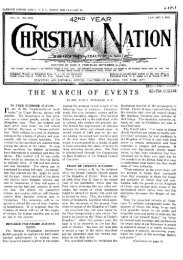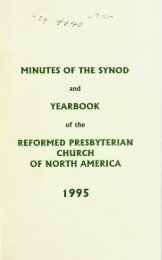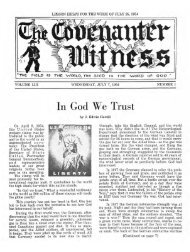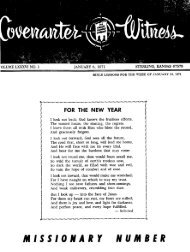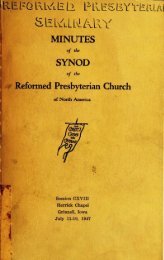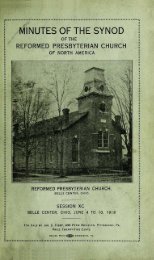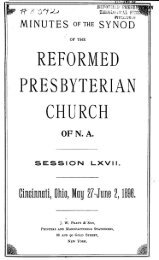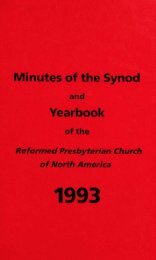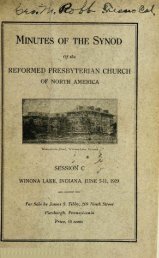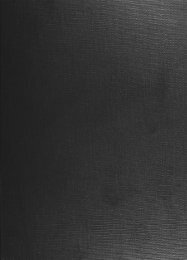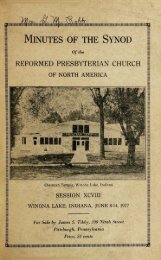Covenanter Witness Vol. 55 - Rparchives.org
Covenanter Witness Vol. 55 - Rparchives.org
Covenanter Witness Vol. 55 - Rparchives.org
Create successful ePaper yourself
Turn your PDF publications into a flip-book with our unique Google optimized e-Paper software.
once."reading;"head to give thanks. As he prayed someone slipped out of the kitchen and whispered in his ear, "Don't touch that food.Pay your bill and leave atStartled, he sniffed the food and dethetected a strange sweet odor, like that ofcyanide. He gladly paid his bill and leftrestaurant, grateful for a protectingProvidence who had sent the unknownfriend to warn him, sparing his life tocontinue preaching the unsearchableriches of Christ. Edward Wyman,Spanish Bible Institute, San Antonio,Texas.The Free MethodistForty-Five Years of Systematic Bible ReadingThis committee was brought into being at the Synod of 1911, as the resultof aTHE BffiLE READING COMMITTEErecommendation in the report ofthe Committee on YoungPeople's Societies of the previous year. The lattercommittee, in its report to the Synodof 1910, recommended that "in view ofthe interest alreadydeveloped in a Bible Reading movement, especially amongthe young people of our church, a committee ... beappointed to preparequarterly folders for the coming year,containing selections from the Bible fordaily morning and eveningand that "this committee formulateplans with a view of interesting all ouryoung people in this movement andsame."keeping up interest in the It washoped that sale of the folders would reimburse the Literarymoneyspent in printing.Fund for theThe early Readers were issued quarterly instead of annually, as at present.Dr. T. H. Acheson, chairman of thatfirst Bible Reading Committee, reportedthat the cost of printingthe foldersamounted to $42.00 and that the salesthat first year brought in $69.65. Postage, however, was not included in theexpenses reported. Receipts continued toexceed expenditures through the years1912 to 1915, but in 1916 the cost wasgreater than the receipts from sales. In1916 the folder was replaced by a booklet, as at present,and the number soldrose from 2000 to 2843. In this year alsoa diploma for perfect readingwas recommended, and these were printed andused in the followingyear. Dr. Achesoncontinued as chairman of the BibleReading Committee until the Synod of1915. when Rev. J. B. Tweed was appointed. He held the chairmanship foronly one year, as did also Dr. H. G. Patterson who succeeded him.In 1917 Dr. Paul Coleman was chosenchairman and held office for threeyears. By dint of sendingletters to allpastors, and in some cases an additionalletter to young people's societies, Dr.Coleman managed to boost sales to 2968copies, the best record up to that time.In 1919 letters were not sent out asheretofore; sales fell of fifteen per cent,and Dr. Coleman resigned as chairman.He was replaced by Rev. O. F.240Thompson, who revived the practice ofsending letters to the pastors urging theuse of the Bible Readers. Sales rose toover 4000.Under his chairmanship aReader was prepared that covered theentire Bible in one year, the cost of thisbeing paid for out of Synod's LiteraryFund. In 1926 and 1927, however, salesfell off somewhat and Mr. Thompson resigned, feeling that new blood was needed on the committee.F. F. Reade succeeded to the chairmanship in 1928 and continued in thatcapacity until 1934. He revived the planof circularizing the pastors of the congregations and, in one of those years,the superintendents of the SabbathSchools also. As a result sales took ajump, in 1930 reaching a peak of 4677.During this period a ChronologicalReader was prepared and published, andalso two sets of Children's Readers. Because of a more favorable printing costin Canada receipts exceeded expenditures, so that in one year, 1931,theCommittee were able to finance a newChildren's Reader without help fromSynod's Literary Fund, and yet show abalance. However, during the depressionyears sales fell off, dropping in 1933 to2190. Yet even in that year the Committee's report showed a net balance of$10.68.Rev. Remo I. Robb became chairmanin 1934 and continued in that capacitythrough 1939. Higher costs in the UnitedStates brought a deficit during his firsttwoyears'incumbency. Although thenext year showed a favorable balancethere was again a deficit in 1937. Expenses rose duringthese years becauseof awards given for six years of satisfactory reading. From this time on Synod's Literary Fund (later known as theMiscellaneous Fund) was constantlycalled upon to helpfinance the cost ofprinting the Readers or of providingawards for earning diplomas.Rev. D. R. Wilcox was made chairmanin 1940. He worked toward the formation of Bible ReadingClubs. Selmastarted that year with a club of 68 members.Sales of Readers again took ajump, reaching a total of 4166. But in1942 sales dropped to 3500; to 3361 in1943; and to 3100 in 1944. The Committee recommended the appointment of anew committee for 1945.Rev. Harold Thompson became chairman in 1945. A new Children's Readerwas published that year, and the committee, with the helpof $45.00 fromSynod's Literary Fund, was able toshow a favorable balance. But the salesfailed to soar as in former years, 2453being sold in 1945, and 2880 in 1946. TheCommittee resigned and a new committee was appointed.Rev. F. F. Reade again became chairman in 1947 and has continued in thatcapacity to the present time. Sales againwent up, 3096 being sold in that year.That, and the fact that the price ofthe Readers were increased slightly, accounts for a net balance being reported.Sales dropped the following year, however, and have never been able to againreach the peak years of 1928-1930, atwhich period sales averaged 4327 copies per year. The average for the pastnine years has been 2071. Perhaps weneed another circularizing campaign.Yet there is a bright side to the picture when we consider the certificatesand diplomas granted for satisfactoryreading, i.e. where no more than twelvereadings have been missed during theyear. When the old style diplomas werefirst given, 67 were earned. The numberof consistent readers fluctuated duringthe next fourteen years, anywhere from21 to 65 beinggranted annually. Thenumber took a jump in 1933 and keptgrowing (except for one year), increasing from 82 in 1936 to 1<strong>55</strong> in 1945.From that date until 1953 the averagenumber of certificates and diplomasearned has been 85. About 200 Bibleshave been awarded since 1933 when thepresent plan of awards was initiated.Printing costs took a decided jump in1948, and have continued to soar eversince. In 1928 our printing bill was$62.40; in 1948 it rose to $113.90; and in1954 it reached $145.49. In 1928 we reduced the prices of the Readers, but in1948 had to restore the former scale.The present committee is of the opinion(and Synod has concurred in it) thatprices should no longer remain at the1927 figure. Therefore the price rangefor the coming year will be ten cents forsingle copies, five cents each for ten ormore, and four cents each for one hundred or more. We trust that the congregations will lend their heartythe Bible Reading Campaign for 1956.support toCOVENANTER WITNESS



